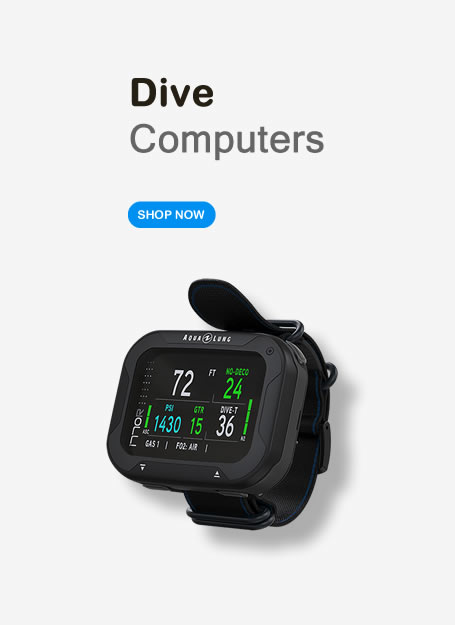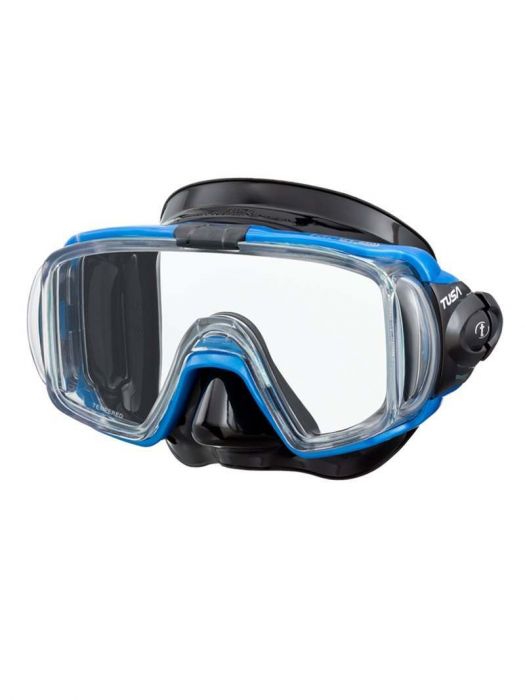
Picking A Dive Mask
When it comes to buying dive and snorkelling kit, one of the most important pieces of equipment to own is the right mask. Not only does the right mask allow you to see marine life underwater clearly, it is also vital for being able to see hand signals and for reading gauges when scuba diving.
Before going any further, it is important to remember that snorkelling and scuba diving masks are NOT the same and snorkel masks must not be used for diving.
Snorkel masks are generally made of affordable materials, such as rubber, and often have plastic lenses, which are perfectly adequate for shallow water use. There are single and double lens snorkel masks available and even a variety of full-face snorkel masks to choose from.
Full face snorkel masks are gaining popularity thanks to their unique curved lens that gives an uninterrupted 180-degree view for the wearer. They also allow the snorkeler to breathe through their nose or mouth, which is helpful for nervous snorkelers who are new to breathing in the water.
Dive masks are made of higher quality materials, such as silicone and shatterproof glass, and are designed specifically for scuba diving. Silicone is more pliable than rubber and forms a better face seal. Dive masks undergo rigorous testing to ensure they function correctly under pressure at depth and there are a number of considerations to take when choosing the right mask.
How to Choose the Right Dive Mask
Before even stepping foot in a dive shop, it worth taking time to consider the type of diving you'll be doing and what is most important to you; be that a wide field of vision, minimal glare, or a mask that is easily recognisable amongst others diving kit. It is also important to consider if you intend to use your mask for travelling.
There are a variety of dive masks available, such as technical diving masks and masks perfect for traveling light. Knowing what your intended use is makes it a lot easier to make the right choice from the start.
Mask Cost
There are dive masks available to suit all budgets and they typically cost from 50 USD up to over 1,000 USD for some full-face diving masks. Whilst it's important not to buy a cheap supermarket snorkel mask for use as a dive mask, the price tag isn't the most important factor when choosing a mask.
If cost is a concern, consider buying a second-hand mask from your local dive club and test it out beforehand. Products recommended or used by other divers can help when selecting the right mask and at the right price.
Mask Fit
If cost isn't the most important factor, what is? The fit of the mask. The most important consideration when choosing a dive mask is always how it fits. A well-fitting mask will prevent water entering the mask and ensure a comfortable dive without the need to repeatedly clear the mask.
People come in all shapes and sizes and there are many masks to choose from that account for different face shapes, head sizes, and nose shapes.
The nose enclosure, or nose pocket, is important when considering fit. A flexible nose pocket allows divers to pinch their nose and equalize easily, whilst the right shape prevents water from entering the mask under the nose. This is especially important for helping to prevent panic in new divers who may be uncomfortable with the feeling of any water around their nose.
It is important to try a variety of masks to find the right fit for you.
How to Ensure a Perfect Fit
There are some simple steps to take to test if a mask fits correctly.
- Hold the mask against your face without attaching the strap behind your head. Let the strap hang loose and out of the way. Make sure all hair is away from the mask.
- Breathe in through the nose, hold your breath and look down and up, or shake your head, to see if the mask stays in place. A well-fitting mask will stay on the face until you exhale.
- Try the mask again, but this time attach the mask straps to see if it is comfortable or tight anywhere on the face. Pay particular attention to any pressure or touching on the bridge of the nose. A well-fitting mask should not cause facial discomfort.
- If possible, wear the mask for a few minutes to see if it still feels comfortable.
A mask should fit to your face underwater without strap pressure being applied, so keep mask straps loose for maximum comfort. Trying to improve the fit of a mask by tightening the straps will only lead to discomfort during the dive. The water pressure will hold the mask against the face one it is sealed on.
Mask Skirt Colour
The silicone area around the lenses that seals onto the face is called a mask skirt. They usually come in clear, black, or white colours and have different advantages.
Clear mask skirts let in more light to the mask, whereas black skirts reduce glare and remove any distraction from surrounding movement or light patterns. White masks, whilst less common, show up well in underwater photography.
A small advantage of the black skirts is that they don't show up dirt, and so look better for longer than clear or white masks.
Number of Lenses
Dive masks are available with single lenses, two lenses, and multiple lenses. They are available within framed and frameless masks.
Single lens masks provide a wide uninterrupted view and maintain binocular vision to help with depth perception. They are good for divers who want a broad view and also allow divers to easily pinch their nose for equalising. Both frame and frameless versions are available.
Single lens frameless masks are low volume, meaning the lens is closer to the eyes and less air is needed to clear the mask underwater. They offer a great field of view and fold flat for packing.
Two lens masks are also low volume and are often designed with tear-shaped lenses. These lenses provide a wide view across the main lens section and a downward view that is great for gear visibility. Being low volume, less air is needed to clear and equalize the mask.
Multiple lens masks have small lenses around the side of the mask in addition to the main lens. They have the broadest field of view and offer great light entry. These masks are good for divers who suffer from claustrophobia.
Full diving face masks are another option, though these are mostly only used by professional divers.
Mask Volume
Choosing a low volume mask is helpful for ease of clearing the mask and also for mask equalising, as mentioned above. There are various low volume masks available, including the popular Aqua Lung Micro Mask which is an ultra-small mask with a wide-angle view.
Divers Who Wear Glasses
Divers who need to wear corrective lenses may prefer to choose a two-lens mask, which can be customised with prescription lenses. Many manufacturers offer pre-made corrective lenses.
Diving with a Moustache
Having a moustache needn't be a problem when choosing a well-fitting mask. Divers with moustaches can select a mask that fits well just as any other diver would. They may wish to take extra precautions pre-dive to prevent the mask from leaking. Shaving the area under the nose or using silicone grease on the mask skirt where it touches the moustache both help ensure a good mask seal.
Low profile masks with soft silicone skirts are popular with moustache divers. Divers could even consider a full-face mask if budget allows, though this isn't usually necessary.
Snorkel Attachment
Whilst snorkels are not used by all divers, they are useful for long surface swims or for snorkelling from a liveaboard when you see something exciting during a surface interval. It is worth checking if the mask you choose comes with a snorkel or if you can attach your own snorkel easily.
Many people attach the snorkel at the side of the mask. An alternative is it attach the snorkel to the mask strap at the back of the head, which holds the snorkel further out of the water when the diver is face down.
Mask Straps
It is worth buying a neoprene mask strap with Velcro fasteners. These straps are easy to use, comfortable, and eliminate hair pulling and entanglement.





All comments